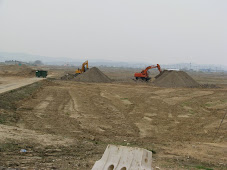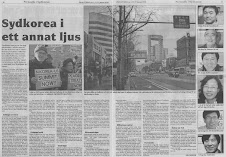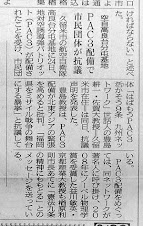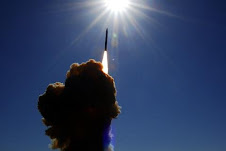 DENNIS ODA / DODA@STARADVERTISER.COM
DENNIS ODA / DODA@STARADVERTISER.COMLt. Gen. Richard Formica, right front, commander of the U.S. Army Space and Missile Defense Command, was on hand yesterday for the dedication of the new Army Wideband Satellite Communications Operations Center at the Wahiawa Annex of Pearl Harbor. The center is one of three big communications projects the Pentagon has undertaken at the Wahiawa Annex in recent years.
 DENNIS ODA / DODA@STARADVERTISER.COM
DENNIS ODA / DODA@STARADVERTISER.COMThe large antenna dishes measure 60 feet in diameter.
 The U.S. Army Space and Missile Defense Command/Army Forces Strategic Command dedicated its new Army Wideband Satellite Communications Operations Center during a ceremony yesterday at the Wahiawa Annex of Pearl Harbor. A tour was held during the ceremony, with one of the stops being inside a giant dome that houses one of the satellite dish receivers.
The U.S. Army Space and Missile Defense Command/Army Forces Strategic Command dedicated its new Army Wideband Satellite Communications Operations Center during a ceremony yesterday at the Wahiawa Annex of Pearl Harbor. A tour was held during the ceremony, with one of the stops being inside a giant dome that houses one of the satellite dish receivers._______________________________________
* Text fwd from Kyle Kajihiro on Feb. 24, 2011
Star Advertizer
The Army facility is one of three big projects undertaken at the Pearl Harbor site recently
By William Cole
POSTED: 01:30 a.m. HST, Feb 24, 2011
Estimates are that four years after the start of the Iraq War in 2003, U.S. government demand for satellite bandwidth jumped from 7 gigabits per second to 12 gigabits.
Military satellite use is increasing, from troops on the ground and unmanned aerial vehicles in the air, to ships at sea.
The Wahiawa Annex of Pearl Harbor near Whitmore Village -- where 60-foot-diameter antenna dishes have sprouted in recent years -- has become a major communications crossroads.
A new 28,244-square-foot, $25.3 million Army Wideband Satellite Communications Operations Center was dedicated yesterday at the annex, bringing a greater capability to manage the river of satellite information that passes through the facility.
The 55 soldiers with Company D of the 53rd Signal Battalion, five Australian service members who augment them, and 10 contractors oversee the communications payload.
The information is transmitted through the Defense Satellite Communications System and Wideband Global Satellite Communication network.
The new center replaces and improves on 1980s-era satellite control capability that before the Wahiawa Annex facility was completed was controlled from Camp Roberts in California.
"Now we're able to provide the combatant commander the capability to have real-time images to make those tough decisions on the battlefield," said Capt. Daniel Zisa, the Company D commander.
The Army's communications center is one of three big projects the Pentagon has undertaken at the annex in recent years.
The National Security Agency/Central Security Service has a new $318 million Hawaii Regional Operations Security Center on 70 acres.
A new $65 million operations center also was built for the Naval and Telecommunications Area Master Station Pacific at the annex, and filled with $92 million in electronics, officials said.
The facility was named the Dan Healy Building after a Pearl Harbor SEAL killed in Afghanistan in 2005.
A Navy official previously called the Wahiawa Annex the most strategic piece of land west of the Mississippi.
"I think what's happening is it's really solidifying its place in the overall communications structure within the United States," said Navy Capt. Patricia Cole, commander of NCTAMS.
Officials say there were about 700 military members and other workers at the Wahiawa facility around 2006-07, and there are expected to be 3,500 by 2013.
Gone from the annex is an old high-frequency antenna known as the "elephant cage" because of its circular shape and high latticework walls, officials said. The design allowed for signal direction-finding.
By 2008, General Dynamics SATCOM Technologies had completed installation of three 60-foot antennas on 53-foot-tall pedestals at the Wahiawa Annex as part of the Mobile User Objective System, a narrow-band satellite communications system. The MUOS antennas joined five already there that are between 40 and 60 feet in diameter, officials said.
The Army's new Wideband Satellite Communications Operations Center has a 38-foot antenna enclosed in a fiberglass geodesic dome.
Officials said Hawaii is a better site for the center than its former location at Camp Roberts in California because of Hawaii's closer location to one of the military's Wideband Global Satellites.
The high-capacity military communications satellite is in geosynchronous orbit at 22,300 miles altitude.
"We call it a look angle," said Master Sgt. Dean McClain, operations officer for the 53rd Signal Battalion.
The angle was low from Camp Roberts and had to look through a lot of space.
"To be physically underneath the satellite is the most advantageous as far as transmission power," he said.
The satellite covers the Pacific Rim and is one of three WGS satellites. Three others are expected to be sent into space in 2011 and 2012.
The military also uses nine older Defense Satellite Communications System satellites. Each WGS satellite has more than 10 times the capacity of the DSCS satellites, according to WGS maker Boeing.
The operations floor of the new Army facility has a very large flat-screen monitor on the wall and 10 individual stations with six computer monitors at each station.
Sgt. Joshua Quenga, 25, who's originally from Maui, takes requests for satellite access. He said he sometimes gets 15 requests at once, and often about 50 requests a day.
"It's busy," he said.
Lt. Gen. Richard Formica, commander of the U.S. Army Space and Missile Defense Command, said yesterday that the center dedication "represents an important milestone in our command's core task to provide trained and ready space and missile defense forces and capability to our combatant commanders and warfighters."
The Wahiawa Annex facility is being used as a model for similar improvements that will be made at satellite centers at Forts Detrick and Meade in Maryland and in Germany.
__________________________________
See also
DMZ Hawai'i
Please don’t build your telescope on Mauna Kea, Mr. Moore
February 24, 2011
DMZ Hawai'i
Protect Mauna Kea
February 24, 2011

![[URGENT PLEA: In Update] EMERGENCY in GANGJEONG Since AUG. 24, 2011](http://2.bp.blogspot.com/-3iz8k-USXVY/TlmRYhhIYtI/AAAAAAAAL2c/9dbF85ZIkIs/s227/jejusit.jpg)



![[Solidarity from Japan for the Jeju] 253 individuals and 16 groups/organizations](http://2.bp.blogspot.com/_gnM5QlRx-4c/TR_YeNVE1yI/AAAAAAAAHWQ/ARyf6oQN0S0/S227/jeju_12_10j.jpg)

![[Translation] Korean organizations' statement: Immediately cancel the joint ROK-US drill Nov 26](http://2.bp.blogspot.com/_gnM5QlRx-4c/TPOE8VKXHFI/AAAAAAAAGlM/8lryt-8sFjc/S227/1.jpg)
![HOT! [Hankyoreh Hani TV] Beneath the Surface: the investigation into the sinking of the Cheonan](http://4.bp.blogspot.com/_gnM5QlRx-4c/TOI83qht8aI/AAAAAAAAGXU/22SW6Q5ntV8/S227/HaniTV%2BCheonan.gif)



![[Translation]Statement against illegal inspection and unjust lay-off by the Kunsan USAFK!(Nov_2010)](http://4.bp.blogspot.com/_gnM5QlRx-4c/TOPLsVkZMqI/AAAAAAAAGZs/3YnnckIyAaY/S227/gunsan%2Bprotest.gif)
![[Translation] Korean organizations' statement against dispatching special force to the UAE on Nov.](http://4.bp.blogspot.com/_gnM5QlRx-4c/TOP95zHXlCI/AAAAAAAAGak/E0Ug1XtUFfM/S227/antiwarpeace.jpg)
![[Translation] Stop, Joining MD!: South Korean activists' statement and writing on Oct. 25, 2010](http://3.bp.blogspot.com/_gnM5QlRx-4c/TOP7Es4_2sI/AAAAAAAAGac/eWVMPD-U4p0/S227/StopMD.jpg)
![[In Update] People First, NO G-20 (Nov. 6 to 12, Korea)](http://2.bp.blogspot.com/_gnM5QlRx-4c/TJd53XBzHlI/AAAAAAAAFQo/ldO9JPE3eqo/S227/left21_G20.jpg)
![[International Petition] Stop US helipad plan in Okinawa to save great nature](http://4.bp.blogspot.com/_gnM5QlRx-4c/TKC2AHRNzBI/AAAAAAAAFUo/yGWXODTw_uM/S227/yanbaru_w.jpg)

![[Global Network] against the first launch of Quasi-Zenith Satellite, Japan, on Sept. 11, 2010](http://4.bp.blogspot.com/_gnM5QlRx-4c/TIowa1boy4I/AAAAAAAAFDI/82rAi98uq-c/S227/Qzss-45-0_09.jpg)

![[In update] Some collections on the Koreans’ protests against the sanction & war on Iran](http://4.bp.blogspot.com/_gnM5QlRx-4c/TJMvke6t8zI/AAAAAAAAFO4/tamQ8LUnOOA/S227/No+Sanction+on+Iran.jpg)
![[Three International Petitions] to End the Korean war and peace treaty(or peace resolution)](http://1.bp.blogspot.com/_gnM5QlRx-4c/THef7bzWxYI/AAAAAAAAE44/wwdzSDfYhdw/S227/border.jpg)



![[Collection of Documents] No Base Learning and Solidarity Program_Korea(June 14 to 20, 2010)](http://1.bp.blogspot.com/_gnM5QlRx-4c/TCTvVuN8NeI/AAAAAAAAEek/8vBJVaHdk10/S227/No-Base-banner.jpg)
![Site Fwd:[John Hines] A U.S. Debate coach’s research trip on the Issues of Korea](http://3.bp.blogspot.com/_gnM5QlRx-4c/TINCO36mzzI/AAAAAAAAE_w/Rds12NcBOXM/S227/Jeju-Peace-Tour.jpg)


![[News Update] Struggle Against the Jeju Naval Base since Jan. 18, 2010](http://1.bp.blogspot.com/_gnM5QlRx-4c/S1vvWaP25uI/AAAAAAAACkg/QvpW1tgOlKM/S226/scrum1.jpg)


![[Urgent] Please spread the Letter!: There was no Explosion! There was no Torpedo! (May 26, 2010)](http://4.bp.blogspot.com/_gnM5QlRx-4c/S_9JmsKEU7I/AAAAAAAAEP8/sAWjSPqxzUI/S227/grounded.jpg)
![Text Fwd: [Stephen Gowans]The sinking of the Cheonan: Another Gulf of Tonkin incident](http://1.bp.blogspot.com/_gnM5QlRx-4c/TAL_FtYKQ-I/AAAAAAAAERE/NEEMijiEcRM/S227/lee-myung-bak.jpg)
![[Japan Focus]Politics in Command: The "International" Investigation into the Sinking of the Cheonan](http://1.bp.blogspot.com/_gnM5QlRx-4c/TBMJ2syJzyI/AAAAAAAAEZU/uTYZccU5vyk/S227/wen_jiabao_and_lee_myungbak.png)
![[Japan Focus] Who Sank the SK Warship Cheonan? A New Stage in the US-Korean War and US-China](http://2.bp.blogspot.com/_gnM5QlRx-4c/S_iQ2vE5ZpI/AAAAAAAAEOU/Oo1SPcAe8FE/S227/buoy_map.gif)
![[Updated on 12/13/10] [Translation Project] Overseas Proofs on the Damages by the Military Bases](http://4.bp.blogspot.com/_gnM5QlRx-4c/S-qSj59gPLI/AAAAAAAAEGM/mwjlFtPE-jo/S227/missile.jpg)
![[International Petition] Close the Bases in Okinawa](http://3.bp.blogspot.com/_gnM5QlRx-4c/S8-z3DYNwNI/AAAAAAAADo4/OswTSchK09M/S227/2.jpg)

![[In Update]Blog Collection: No Korean Troops in Afghanistan](http://4.bp.blogspot.com/_gnM5QlRx-4c/SwnlLD9IewI/AAAAAAAAB9E/oUPssnpNidA/S226/No-Troops-to--Afghanistan.jpg)











No comments:
Post a Comment